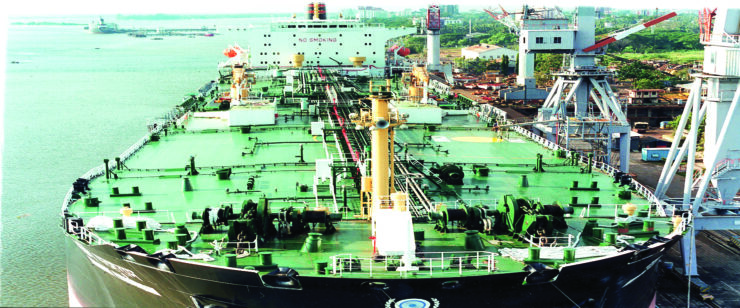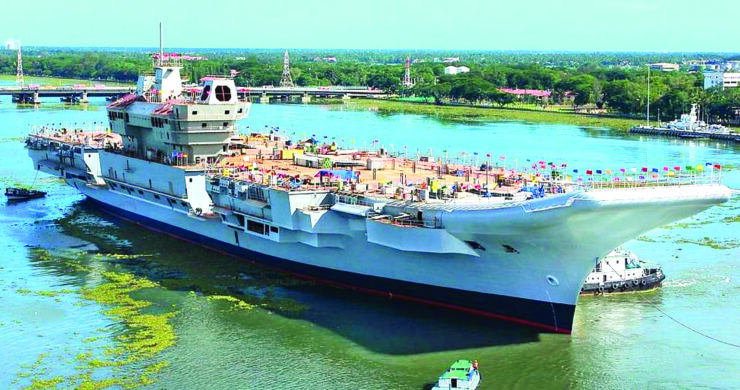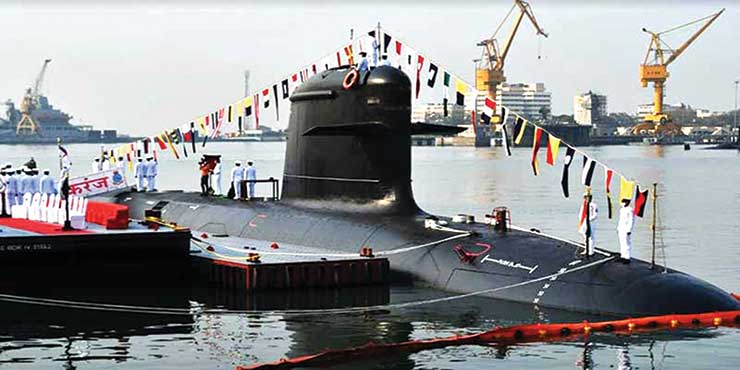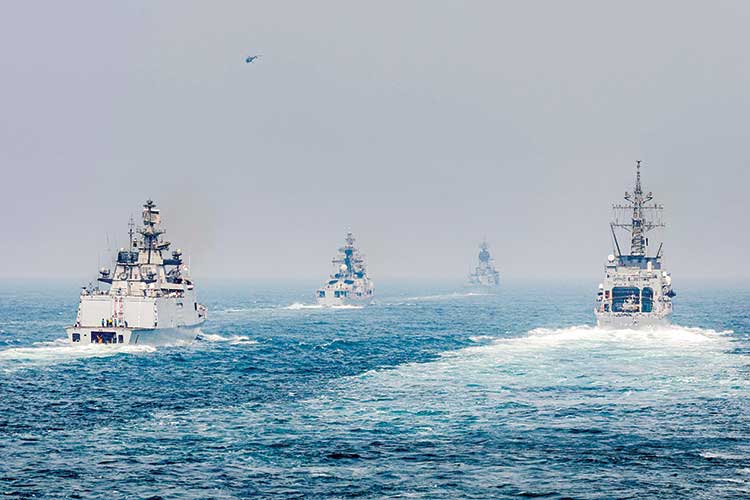
It is ironic that it took the Sino-Indian confrontation in the Himalayan heights, more than 2,000 km from the sea, to bring sharp focus on India’s neglected maritime domain. The Chinese were obviously surprised by India’s military response, backed by firm political resolve, and this, probably, influenced their decision to commence disengagement in March this year. But even in the unlikely event that the status-quo ante is restored along the LAC, China’s territorial transgressions have imposed heavy costs on India, which cannot be ignored.
While the political consequences of these intrusions may be manageable, it is the price being paid, in terms of far-reaching economic and security penalties, which is cause for concern.
To compound an already complex security matrix in South Asia, we have seen the precipitate withdrawal of US and NATO forces from Afghanistan, and the virtual abandonment of the country to a barbaric Taliban regime.
Given the huge stakes that Pakistan, China, Russia and Iran have in Afghanistan, the emerging power-play is bound to have a deep impact on India’s security. This calls for a well-thought-out strategy by our diplomats and contingency-planning by the military.
In the context of our own security, we must face the stark reality, that given the huge asymmetry—economic, military and technological—between the two Asian giants, and the active China-Pakistan nexus, the best that India can hope for, is stalemate on its northern and western land borders. So, are there any options in the maritime domain that can help checkmate China?
One is not sure how well maritime affairs and the employment of sea-power are understood in Raisina Hill
While the Indian Navy (IN) has clarity about its roles and capabilities, in the Indian Ocean as well as the larger Indo-Pacific, one is not sure how well maritime affairs and the employment of sea-power are understood in Raisina Hill.
There is, however, a vague, emerging view, that India’s sea-power, perhaps on its own, but certainly in partnership with others, can exert significant leverage vis-à-vis China, and prevent it from undertaking actions inimical to India’s interests.
Maritime Coercion?
British historian, Prof. Geoffrey Till has suggested that, since “The costs and uncertainties of war are so, potentially horrendous, that the use of coercive force to influence behavior of others and to get them to do what you want them to by means, well short of war…” is worth exploring.” Naval coercion was the instrument used by European powers, from the 15th century onwards, to colonise the East, and Indians must never forget it.
The practitioners of sea-power, as well as our political masters would be well advised to study the historic use of maritime power in depth, and while doing so, they should pay heed to what another historian, Julian Corbett, had to say:
“Since men live upon land and not upon the sea, great issues between nations at war, have always been decided, either by what your army can do against your enemy’s territory and national life, or else by the fear of what the fleet enables your army to do.”

For many years, under the influence of Admiral Mahan’s writings, we had imagined that the raison d’etre of navies was only to engage the enemy in a big battle at sea, and plans were shaped accordingly. However, the lessons that emerged over time, clearly conveyed that navies, like ours, cannot achieve any decisive results by conducting maritime operations in isolation. Our doctrines, now acknowledge that, unless the navy’s actions at sea have a strong linkage, with events on land, its potential would be wasted.
A bigger struggle that India’s naval leadership had to wage for many years, was in trying to persuade our land-oriented decision-makers that India’s security as well as destiny was heavily dependent on the oceans surrounding this peninsular nation. Many factors have contributed to bring about the change in attitudes, but we still have a long way to go before maritime power receives its due in India.
The Doctrinal Void
That India should have a navy, has never been a matter of contention, and yet, no serious debate ever took place about its size, shape and roles; thus, leaving us in a doctrinal void. Even after 71 years as a sovereign republic we lack a clearly articulated statement of national interests, aims and objectives. This strategic vacuum had tended to deny the IN a contextual frame of reference, and that is why we did not produce a maritime doctrine for many years.
History shows that there is little point in accumulating military power, unless there is clarity about doctrine and strategy to guide its employment. There are many past examples of countries like Indonesia, Egypt, Syria, Iraq, (and now Afghanistan) which were amply endowed with foreign weaponry, but failed, in conflicts, because their planning and operations lacked doctrinal underpinning and forces lacked motivation.
For many years, India, too, has suffered from a lack of doctrinal clarity; not only at the highest political level where Grand Strategy is to be formulated, but also amongst the Service HQs and war-fighters. In order to address this vacuum, the IN, during the first decade of this century, took up the challenge of drawing up a roadmap to synergise its maritime endeavours.
In October 2005, Naval HQ issued a Maritime Strategy, which became the companion volume to the Maritime Doctrine which had been issued in 2004.
The Strategy and Doctrine were logically followed by a blueprint for naval force development titled, ‘Maritime Capabilities Perspective Plan; 2005-2022,’ which set out the capabilities and hardware required.
While figures ranging from 190 to 300 ships had been mentioned from time to time, NHQ decided to be as realistic as possible, by using conservative figures for GDP growth rate, defence budget and the navy’s share, and sought a stabilized strength of about 150-170 ships and submarines, and 350-400 aircraft, helicopters and unmanned aerial vehicles. All these documents have been revised and updated during the past decade.
Utilizing Sea Power
The end of the Cold War brought winds of change in foreign policy and saw India responding to US overtures, which eagerly sought military to military cooperation with India. The IN took a lead by initiating the first ever Indo-US naval exercises, named ‘Malabar,’ which became a precursor for bilateral exercises with at least a dozen other navies.
India’s growing dependence on seaborne trade and energy supplies, coupled with its demonstrated naval capabilities saw growing acceptance of its role as a regional maritime power.
Despite the absence of any joint contingency planning, the conflict arising from Pakistan’s 1999 incursion into Kargil saw the IN undertaking the mobilization and concentration of both Western and Eastern fleets in the Arabian Sea. This overt display of maritime muscle sent the appropriate message to Pakistan. Fearing the imposition of a blockade or ‘maritime exclusion zone,’ the Pakistan Navy ordered its units to stay in harbour.
The 2004 tsunami marked a defining moment which established the IN as a credible regional force of substance. The navy’s ships, aircraft and helicopters sped, to render humanitarian aid and disaster relief (HADR), not just to India’s own stricken citizens but also to its Sri Lankan, Maldivian and Indonesian neighbours in distress.
IN operations, now, extended far and wide across the larger Indian Ocean and even beyond. While mounting sustained anti-piracy patrols off the Horn of Africa, it reacted, with alacrity, to many HADR situations in our extended neighbourhood.

Closer home, the Mumbai terrorist strikes of November 2008 provided a grim reminder that the maritime domain constituted a huge liability which India could neglect only at great peril.
Of the numerous, sea-power-related issues that bear review or scrutiny, I take up just two, that have most relevance to the topic under discussion: foreign cooperation and warship building.
Foreign Cooperation
For many years, China’s, so-called, ‘string of pearls’ and, the more recent, ‘maritime silk route’ strategy has been causing concern in New Delhi. The obvious answer, was for India, to craft a long-term counter-strategy, based on economics, geo-politics and hard, as well as soft-power.
The Navy had an important role to play, in this, because after its sterling performance during the 2004 tsunami, and in many subsequent episodes of natural disasters and civilian evacuations from the Middle-East and Africa, India’s neighbours expected prompt assistance from the IN in times of need.
Our smaller neighbours sought maritime security; either through direct naval presence, or through requests for material aid, training assistance and advice. Our response to such requests was not always prompt due to lack of coordination and synergy between Naval HQ, MEA & MoD. Lengthy delays were seen, by our smaller neighbours, as lack of urgency, or even as indifference, and they often chose other alternatives.
After futile attempts to create a ‘whole of government’ approach to this issue, NHQ decided to invest its ‘naval diplomacy’ with a degree of limited autonomy. This was done by: (a) creating a new organization which would deal exclusively with the navy’s foreign cooperation programmes, and (b) by rendering material assistance from within NHQ resources, keeping MoD and MEA informed.
Thus, in the first year, we pulled out surplus hardware, including an offshore patrol vessel, two patrol boats and three light reconnaissance aircraft and gifted them to neighbouring navies garnering much goodwill.
Thus, foreign cooperation, as a vital component of the IN strategy, has not only to enabled it to create friends and partnerships, but also to familiarize itself with the future battle-space.
Warship Building
There was a time, when the IN appeared to be one of the world’s fastest growing maritime forces. But even then the picture was not entirely rosy for two reasons. Firstly, the public-sector shipyards, with one exception, did not rise to the occasion and their slow production rates have been inadequate to sustain the desired force-levels. Secondly, the Russian military-industrial complex on which India’s warship building industry remains heavily dependent, for machinery, weapons and sensors, suffers from problems of quality-control and lack of response.
A closely related aspect and a second area of concern is the low level of home-grown technological inputs into ‘indigenous’ warships. Despite the Navy’s determined support to indigenous industry, all types of engines, most weapons, sensors and other systems installed on-board are still imported. This external reliance has created a dangerous security paradigm in which every new weapon system acquired from abroad creates dependency for the life-time of the system.
Persuading the defence R&D establishment to develop, reverse-engineer or buy/import weapon and sensor technologies for Indian-built warships will constitute a major challenge for future growth of the IN.
The recent ban, by the government, on import of certain items of defence hardware, under the Atmanirbharta campaign, may be well-intentioned, but requires modification. A ban on import of a destroyer, fighter or submarine may sound fine, but what about the engines, radars, weapons and other systems that still have to be imported? This ban will be productive, only if we, simultaneously, push an integrated programme for indigenous development of key technologies.
Against this backdrop, let us, now, discuss the options that sea-power has to offer in the domain of national security.
India’s Maritime Options
In the current scenario, given Chinese intransigence and our misreading of their expansionist intent, Sino-Indian tensions are likely to persist. If India is not to cede ground physically or diplomatically, it must muster all elements of its ‘comprehensive national power’, including sea-power, and create a strong negotiating position.
This seems all the more reason for India to try shifting the confrontation to ‘sea-level’, where its geographic advantages, tilt the asymmetry in its favour. In a longer-term perspective, two readily available options that need serious examination by India are ‘naval coercion’ and ‘naval diplomacy’ or coalition-building.
Naval coercion comprises two closely related dimensions; deterrence and compellence. Acts of deterrence are aimed at preventing a particular act, by showing the adversary that the costs will outweigh the benefits. It is based on potential, rather than actual use of force, and since it is a psychological phenomenon, its effectiveness is based on the clarity of aim, as well as resolve, demonstrated by the political leadership.
The other requirement for effective deterrence is to create a sufficiency of maritime power to include air-power—ship-based as well as land-based—and missile-armed warships and submarines. The IN, in spite of fiscal constraints, has emerged as a compact but professional and competent force, and India’s fortuitous maritime geography will enable it to dominate the Bay of Bengal and the Arabian Sea.
India’s favourable maritime geography enables the peninsula to dominate both the Bay of Bengal and the Arabian Sea. This geographical disposition highlights the advantages of its ‘interior lines of communication’ as compared to 8,000-10,000 km long ‘exterior lines’ that separate Chinese naval bases from Indian Ocean locations. We must, however, bear in mind that the PLA Navy is underpinned by a powerful economy and supported by an efficient and prolific shipbuilding industry.

Apart from boosting the navy’s capabilities, fortification of the A&N Island chain, located astride the mouth of the Malacca Strait, will add, significantly, to naval deterrence. By maintaining surveillance, over the exits from the South China Sea, India can create a ‘forward maritime defensive line.’
This brings us to the other aspect of naval coercion, ‘compellence’, which by threat of force, obliges an adversary to do something or behave in a certain way. During wartime, trade warfare and ‘commerce raiding’ are feasible strategies and belligerents may declare an ‘exclusion zone’ or naval ‘blockade’; denying entry and exit to all merchant shipping from the latter’s ports. In peacetime, however, a different set of rules apply.
Given that China is the world’s largest trading nation, its seaborne trade and energy imports constitute a vulnerable ‘jugular vein,’ and regardless of buffer stocks, any disruption or delay of shipping traffic could upset China’s economy, with consequent effects on industry and morale of population. Therefore, launching ‘maritime interception operations’ which involve stopping and boarding or diverting Chinese merchant shipping, especially oil and gas tankers, could constitute a useful option for compellence.
Coming finally, to collaborative naval diplomacy and coalition-building to secure foreign policy objectives. In this context, two templates are available to India: ‘Malabar’ and the Quadrilateral Security Dialogue or ‘Quad.’
‘Exercise Malabar’ goes back to 1992, when India and the US first established military-to-military relations. With a brief interregnum, in the aftermath of our 1998 nuclear tests, Malabar has been ongoing for nearly three decades. It has evolved from a bilateral event involving just the Indian and US navies, to a tri-lateral that embraced Japan, in 2015, and now to a four-cornered naval drill that also includes, Australia. Year 2021 saw the 26th edition of Malabar being conducted in the Philippine Sea, with all four navies participating and US playing host.
The Quadrilateral or ‘Quad,’ on the other hand, traces its origins to the great Asian tsunami of December 2004, when the IN was joined, by navies of the US, Australia and Japan to form a Joint Task Force, and a ‘core group’ of senior diplomats representing the four powers was formed to coordinate relief efforts. This Quadrilateral Security Dialogue became the ‘Quad.’
China’s extreme concern about Malabar as well as the Quad arises from the suspicion that they are precursors to a US-initiated strategy of ‘containment.’ So far, China has succeeded in intimidating most of the Quad members, who have remained extremely reluctant to take a firm stand vis-à-vis China’s aggressive conduct.
While Quad and Malabar have served a useful purpose, a reappraisal of both concepts is overdue. For India, which faces a massive Chinese military mobilization on its borders, accompanied by blatant territorial claims, the time for ambivalence is over. While preparing to fight its own battles, it is time for India to seek external balancing, via the maritime domain. Using the Quad and Malabar templates, it needs to give concrete shape to these alliances and partnerships, so that China gets the right message.
Conclusion
History shows that neither appeasement, nor empty rhetoric has deterred hegemonic powers. India has, with considerable exertion and at substantial expense, stabilized the military situation in Eastern Ladakh for the time being.
But we face an adversary who is ruthless, ambitious and unpredictable. Today, real-politik demands that India takes necessary steps to ensure a favourable regional balance-of-power through cooperation and partnerships; striking short-term alliances if necessary.
Sea-power is a potent and flexible instrument that can be used to convey messages and influence events through the use of a broad spectrum of naval actions, ranging from coercion at one end, to naval diplomacy or coalition-building at the other end. But for this to happen, navies, bureaucracies, diplomats and statesmen need to evolve a strategic approach to maritime power and integrate it with the country’s diplomacy and larger security strategy. The navy has done its bit in the fields of doctrine and strategy, it is, now, up to our security decision-makers to evolve a ‘whole of government’ approach.
–The author is a retired Navy Chief. The views expressed are personal and do not necessarily reflect the views of Raksha Anirveda








